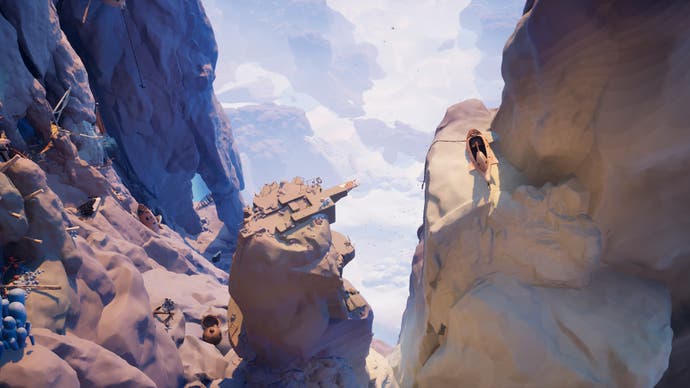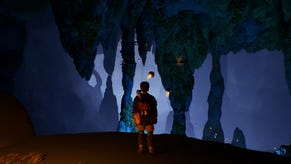Jusant's jump is one of the greatest things in games for an absolute age
Bring on the wall!
I'd never normally start with a definition, but I gather "jusant" translates as "ebb", the movement of the tide out to sea. And this is where Jusant's Steam demo begins. What manner of post-apocalypse is this? It's a dry one. The water has gone, we walk over sun-baked earth whose smoothness suggests that it was once far below the ocean, and there's more to climb here because there's less liquid moving around to cover it all up.
This is an apocalypse that's doing double duty. It doesn't just give you an end-of-the-world you can understand, but it gives you a look too. When I first saw Jusant in the Xbox Summer Showcase, I thought it was channeling Gaudi a bit. Shards of pottery and bleached bone and all that jazz. Turns out that Gaudi's encrusted art style matches rather closely with the things the sea leaves behind. Arches of whale bone, rust, glinting coral. Metal things with corners rubbed smooth, paint long gone, shapes part eaten away, part broken.
This stuff is everywhere in the Jusant demo, which is, I will tell you now, a bit of a treat. You are a lone traveller faced with a huge tower to climb. A mountain, but also more than a mountain. It's had bits added on, bits drilled into it. It goes up but in a higgledy human way. You're ascending, but you're also exploring upwards, starting amongst old fish nets, coils of rope, planks of wood, moving on to broken metal rungs, stones poking out of the wasted aggregate. Upwards and upwards, weirder and weirder, outside and indoors. Even in the demo it's quite a journey.
Jusant uses the climbing system I first encountered in Grow Home: one trigger for each of your grabby hands. It's a lovely way of doing things, because it roots you in the body, and makes you consider your reach, the movement of arms, the potential of limbs to cross-over and tangle. That squeezing of the triggers also makes it densely physical. I feel, in some small way, the exhaustion of the climber, because I am gripping this thing along with them.
Jusant takes things further, though. It throws in a wonderfully physical jump - an absolute blinder of implementation, in which you hold a button to power up, and then lunge the left stick in the direction you want. The character leans. You check your angles. You let go and jump and hope you connect, hope you grip on in time. It's one of the single best things I've seen in games for ages, a gorgeous piece of control design. I never once started to take it for granted in the demo. I never internalised it to the point where I could forget it. It was always a joyful terror, a real risk.
Beyond that you have a carabiner you can clip on to arrest your fall - I got the rope gloriously tangled up once or twice and the game made it work - and you can bang in pitons to help when you get really stuck. You have three pitons to use at once, so you have to pace yourself, and there's a really pleasing flash of ritual when you heave yourself over a ledge and magically retract the carabiner and the pitons: made it.

The other thing you need to keep an eye on is stamina, which you can temporarily reset on the wall by holding in a thumbstick. Loose stamina and the sound drops, you hear the blood in your ears, you can imagine limbs growing heavy, you fall. It's funny: Jusant is clearly science fiction, but it's in love with climbing in a way that feels - to me at least - surprisingly realistic.
The level design is magic, if you ask me. The wall is great at leading your eye, giving you options, while also telling you a little bit about the people who have survived the catastrophe with all the water disappearing. And while you're outside quite a lot, the game knows when to lead you indoors, the route upwards passing through little hollows that steadily become mini apartments, cave networks, everything eaten by rust, sagging with neglect.



It's great when things go well and you reach the ledge you've been aiming for for the last ten minutes. Thrillingly, though, it's great when things go wrong. I missed a jump at one point and rather than falling to my death and a restart, the carabiner saved me, and I was able to do a sort of arcing wall run to build momentum and work my way back up. There's a bit of dodgy physics here and there, but look what the game is doing, look at that line flexing and tightening behind you, the need to follow you as you turn on a wall, as you go out and over and under a spar of hanging rock or an old piece of timber.
By the time I reached the end of the demo, I was properly in love. And what's this? I wasn't really that high up. I mean, I was high up enough to give me a bit of vertigo, but the mountain tower itself still went far higher, up into the sky. What would I find up there? Can't wait to see.








